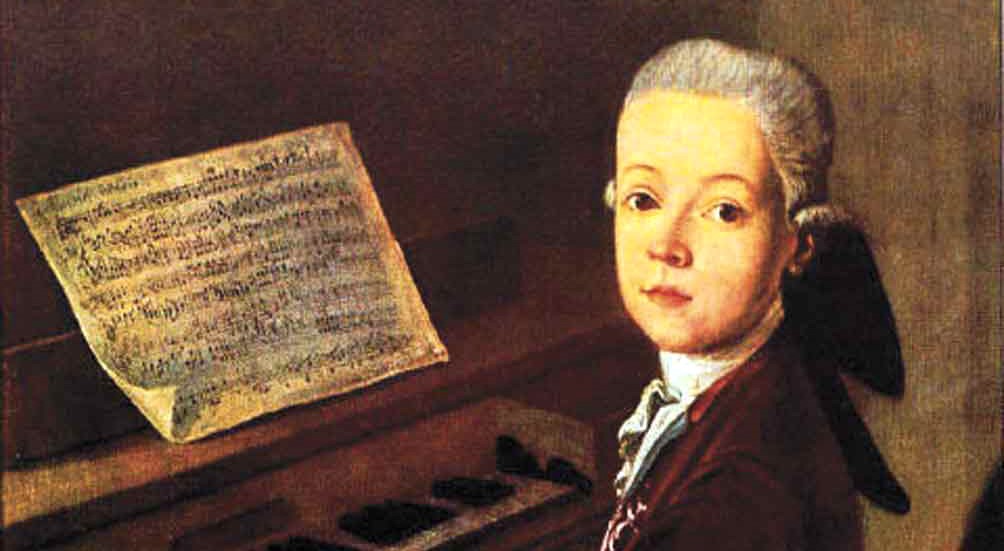Wolfgang Amadeus Mozart is one of history’s most celebrated composers, and his vast oeuvre spans a wide range of emotions.

The young Wolfgang Amadeus Mozart
But when it comes to expressing joy and exuberance, no other composer has Mozart beat. His ability to embody joy in his work is like no other composer’s.
The question of which of Mozart’s hundreds of works is his happiest is, of course, subjective. But today we’re looking at eight pieces that are worth putting on any “Happy Mozart” playlist.
“The Marriage of Figaro” – Overture
Mozart’s opera The Marriage of Figaro follows a madcap day of comedic misadventures in a count’s palace. Said misadventures are too numerous to list here, but they include scheming by a skirt-chasing count, servants counter-scheming, and a close call with a forced marriage to what would have been the groom’s mother. Wild stuff!
This screwball atmosphere is perfectly captured in Mozart’s bubbly, maniacally excited overture. As legend has it, he wrote it mere hours before its premiere.
Violin Concerto No. 1, Movement 3
Scholars have decided that Mozart wrote his first violin concerto when he was just seventeen years old, in 1773, and that youthful energy really permeates this presto finale.
The rapid fire scales are saucy and sassy. The trills are thrilling. And the quick string-crossing passages are some of the most outwardly virtuosic music that Mozart ever wrote for violin.
Maybe it’s a little repetitive in places, but that’s nitpicking. The bottom line is, this piece’s joy is contagious.
Clarinet Concerto, Movement 3
This is one of the last pieces Mozart wrote before he died, but it’s brimming with life.
This clarinet concerto offers a more mature, relaxed joy than the first two pieces on this list. But that maturity fits the mellower tone quality of the clarinet well.
This rondo finale sounds like graceful dance music played at a lovely ball. Every time the elegant main theme returns, it’s impossible not to smile.
Sinfonia Concertante for Violin and Viola, Movement 3
This is one of the more unusual entries in Mozart’s output. It features two solo instruments: the violin and, unusually, the viola. These two voices are rarely heard together as joint soloists, so this piece is a real treat.
The biggest joy here comes from hearing the two instruments interact with each other, copy each other, play in unison, comment on what the other instrument is saying. It really does sound like they’re having an entire conversation without words. It’s easy to picture them both as characters in some comedic opera whose plot we listeners get to make up as we listen.
Piano Sonata No. 11, Mov 3, Rondo Alla Turca
This is one of the most famous Mozart pieces of all time.
Any listener will immediately notice that this work sounds unlike Mozart’s other music. This is because it was inspired by a popular music trend of the time: Turkish Janissary bands.
Ottoman military bands are the oldest military bands in the world, and by Mozart’s time, they’d been around for nearly five hundred years. Mozart was based in Vienna, a city that had witnessed multiple conflicts with the Ottomans in previous generations.
As you can imagine, the Austrian Mozart’s relationship with the rich musical tradition of the bands was an extremely complicated one, and it’s impossible for a modern listener to fully absorb how this piece both pays tribute to and subverts that rich tradition.
That said, this finale’s brash cheerfulness makes it a shoo-in for this list.
Oboe Concerto, Movement 3
The finale to Mozart’s oboe concerto is just plain adorable.
Mozart wrote it when he was 21, and it is one of the most important oboe concertos in the repertoire. The following year, he reworked it as a flute concerto.
After Mozart’s death, it was considered lost. It wasn’t until 1920 when conductor Bernhard Paumgartner (Herbert von Karajan’s teacher) came upon a handwritten manuscript in the Salzburg Mozarteum archives. So there’s a happy story for you: a Mozart classic that we thought had been lost forever, that was found and resurrected!
Divertimento in D major, K. 136, Mov 1
This divertimento was an entertaining side project for a 16-year-old Mozart (at the time, he was working on an opera).
Its lightning-fast passagework, call and response portions between string sections, and unrelenting eighth-note baseline all combine to charm listeners and players alike.
Watch out for the lovely, delicate contrasting section that serves to make the returning joy of the main theme all the more delightful.
Symphony No. 41, Jupiter, Mov 4
Drumroll, please! This may be the happiest music that Mozart ever wrote.
This is the last movement of his last symphony, nicknamed the Jupiter. The element that makes it such an explosion of happiness is its mind-boggling technical achievement of containing a five-voice fugato.
Author Sir George Grove famously wrote of this movement, “It is for the finale that Mozart has reserved all the resources of his science, and all the power, which no one seems to have possessed to the same degree with himself, of concealing that science, and making it the vehicle for music as pleasing as it is learned. Nowhere has he achieved more.”
And nowhere did he write more joyful music. This is joy stacked on top of joy, five times over.
As a bonus, if you want to see how all of those themes work together, take a look at this analysis and deconstruction:
So there you have it: eight picks for Mozart’s happiest music. What happy Mozart movements do you return to again and again? Let us know. Happy listening!
For more of the best in classical music, sign up for our E-Newsletter


Mozart has been and still is my favorite composer. Impossible to choose between his numerous beautiful pieces of divine music.
Thank you so much for this delightful selection, culminating in the astonishing achievement of the Jupiter. And the analysis — what a great bonus! Mozart forever.